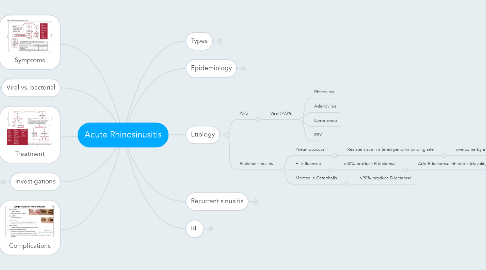
1. Symptoms
1.1. Major (2 or more)
1.1.1. Discharge
1.1.1.1. Anterior
1.1.1.2. Posterior
1.1.2. Blockage
1.1.3. Facial pain
1.1.4. Hyposomnia/anosmia
1.2. Objective findings
1.2.1. Endoscope
1.2.1.1. Polyps
1.2.1.2. Mucopurulant discharge from middle meatus
1.2.1.3. Obstruction at the middle meatus
1.2.2. and/or CT findings
2. Viral vs. bacterial
2.1. Think bacteria
2.1.1. Bad onset
2.1.1.1. Severe onset with fever and facial pain
2.1.2. Persistent
2.1.2.1. Persistent beyond 10days w/o improvement
2.1.2.1.1. If you culture beyond 10days, 60% will grow bacteria
2.1.3. Improvement followed by worsening
2.1.3.1. The best sign (double worsening)
3. Treatment
3.1. Abx
3.1.1. Amoxicillin (in canada) or beta lactam allergy, use either septra or macrolide
3.1.1.1. high dose amox if endemic of resistant pneumococcus
3.1.1.1.1. Add clav if beta lactase producing organism
3.1.2. Pencillin allergic
3.1.2.1. Fluroquinolone or doxycyclin
3.1.2.2. If type 1
3.1.2.2.1. Levofloxacin
3.1.2.3. If other type
3.1.2.3.1. in children
3.1.3. NNT is 18 and NNH is 8 (number need to harm(
3.2. Duration
3.2.1. 2wks for peds
3.2.2. 1wk for adult
3.3. INS
3.4. Nasal irrigation
4. Investigations
4.1. Culture
4.1.1. Number 1, it should be sinus culture not nasal because nasal culture has Poor correlation w/ sinus culture
4.1.2. Do enodscopy culture if patients failed medical management
4.1.2.1. Resistent
4.1.2.2. Unusual organism
4.2. CT
4.2.1. Is usually not indicated
5. Complications
5.1. Abx doesn't make a different in healthy population
6. Types
6.1. Acute
6.1.1. <4wks
6.2. Subacute
6.2.1. 4-12wks
6.3. Chronic
6.3.1. >12wks
7. Epidemiology
7.1. Prevalance
7.1.1. 20%
8. Etiology
8.1. ARS
8.1.1. Viral >90%
8.1.1.1. Rhinovirus
8.1.1.2. Adenovirus
8.1.1.3. Coronavirus
8.1.1.4. RSV
8.2. Bacterial sinusitis
8.2.1. Pneumococcus
8.2.1.1. Resistent strain altered pencillin binding site
8.2.1.1.1. overcome by increase the dose of amoxicillin
8.2.2. H. Influanzae
8.2.2.1. >50% produce B-lactamse
8.2.2.1.1. Add B-lactamse inhibitors (clavulin)
8.2.3. Morexella Catarrhalis
8.2.3.1. >90% produce B-lactamse
9. Recurrent sinusitis
9.1. 4 or more /year
9.2. r/o underlying problem
9.2.1. PID
9.2.2. CF
9.2.3. AR
9.2.4. Structural
10. RF
10.1. Dental infections
10.2. Anatomic abnormalites
10.2.1. Septal deviation
10.2.2. Haller cells
10.3. Smoking
10.4. Pollotion
10.5. AR might be a RF
10.6. ICAM1 upregulation
10.6.1. Receptor for rhinovirus
10.7. ICU
10.7.1. Intubation
10.7.2. NG
